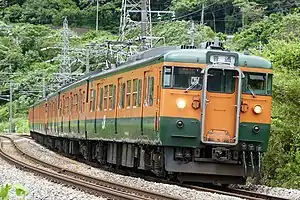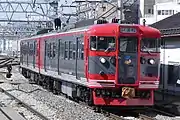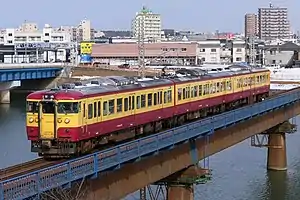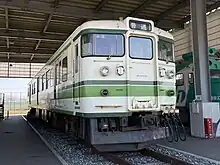| 115 series | |
|---|---|
 A 6-car 115 series formation in Shonan livery on the Jōetsu Line in June 2017 | |
| In service | 1963–present |
| Replaced | 80 series |
| Constructed | 1963–1983[1] |
| Entered service | March 1963 |
| Refurbished | 1998– (for selected 115 series trains) |
| Scrapped | 1987– |
| Number built | 1,921 vehicles [1] |
| Number in service | 275 vehicles (as of April 2023) |
| Number preserved | 2 vehicles |
| Successor | E129 series, 211 series, 223 series, 227 series, E231-1000 series, 311 series, 313 series |
| Fleet numbers | A01 – A17, C13, C21, D01 – D31, G01 – G08, L01 – L22, L99, N01 – N21, O03 – O04, R01 – R05, T11 – T14, T1020, T1022, T1032, T1036 – T1041, T1043 – T1044, T1046, T1090 – T1091, T1133, T1142 – T1145, T1147, T1159 |
| Operators |
|
| Depots | Toyoda Nagano Niigata Fukuchiyama Okayama Hiroshima Shimonoseki Togura |
| Specifications | |
| Car body construction | Steel |
| Doors | 3 pairs per side 2 pairs per side (115-3000 series) |
| Maximum speed | 110 km/h (68 mph) |
| Traction system | Resistor control |
| Electric system(s) | 1,500 V DC overhead lines |
| Current collector(s) | Pantograph |
| Braking system(s) | Dynamic braking for retarder |
| Safety system(s) | ATS-S, ATS-P |
| Coupling system | Shibata |
| Track gauge | 1,067 mm (3 ft 6 in) |
The 115 series (115系, 115-kei) is a DC electric multiple unit (EMU) train type developed by Japanese National Railways (JNR) and now operated by West Japan Railway Company (JR-West), and the Shinano Railway.[2]
Operations
JR East
JR East operated their last 115 series train on 11 March 2022.[3] 115 series trains were previously used on the Shōnan-Shinjuku Line, Takasaki Line, Utsunomiya Line, Chuo Main Line(East Line), Shinonoi Line, Oito Line, Agatsuma Line, Ryomo Line, Joetsu Line, Shinetsu Main Line, Yahiko Line, and the Echigo Line.
JR-West
Currently used on the Hakubi Line, Maizuru Line, Sagano Line, Sanin Main Line and the Sanyō Main Line
JR Central
Formerly used on the Minobu Line, Gotemba Line and the Tōkaidō Main Line. Sets owned by JR East currently operate on the JR Central Iida Line and Chūō Main Line (West Line).
Shinano Railway
Currently used on the Shinano Railway Line. Start of retirement in July 2020 with the debut of the new SR1 series on 4 July 2020. [4]
Variants
115-0 series
This is a cold-weather and mountainous line version of the earlier 113 series. The first examples were introduced from 1963 on the Takasaki Line out of Ueno.
 115-0 series in 1989
115-0 series in 1989
115-300 series
Air-conditioned version introduced from 1973.
 115-300 series in 2008 January
115-300 series in 2008 January Interior view in November 2014
Interior view in November 2014
115-1000 series
Introduced from 1978 with increased seat pitch and improved cold-weather performance.
 115-1000 series in January 2017
115-1000 series in January 2017 Interior view in October 2021
Interior view in October 2021 Priority seating in October 2021
Priority seating in October 2021
115-2000 series
Hiroshima, Shimonoseki and Shizuoka area version introduced in 1978. Specifications based on 115-1000 series.
 115-2000 series in March 2009
115-2000 series in March 2009
115-3000 series
Two-door version introduced from November 1982 to replace 153 series EMUs on "Rapid" services in the Shimonoseki area.
 115-3000 series
115-3000 series Interior view in December 2021
Interior view in December 2021 Priority seating in December 2021
Priority seating in December 2021
115-3500 series
Former 117 series MoHa 117 and MoHa 116 two-door cars converted from May 1992 for use in the Okayama and Hiroshima areas.
 Moha115-3500 in March 2009
Moha115-3500 in March 2009
115-6000 series
JR-West 2-car sets converted in 1999 by building new cabs at one end of former MoHa (non-driving motor) cars.
 115-6000 series in August 2006
115-6000 series in August 2006
Livery variations
 Shōnan livery in April 2022
Shōnan livery in April 2022 "Suka" livery in November 2018
"Suka" livery in November 2018 Minobu Line livery in November 1983
Minobu Line livery in November 1983 Original Nagano livery June 2018
Original Nagano livery June 2018 New Nagano livery in January 2008
New Nagano livery in January 2008 Coca-Cola livery
Coca-Cola livery First Niigata livery in 1989
First Niigata livery in 1989 Second Niigata livery in February 2007
Second Niigata livery in February 2007 New Niigata livery in February 2007
New Niigata livery in February 2007 First Yahiko Line livery in October 2020
First Yahiko Line livery in October 2020 Second Yahiko Line livery in March 2015
Second Yahiko Line livery in March 2015 Setouchi livery in June 2008
Setouchi livery in June 2008 Hiroshima Rapid livery in August 2008
Hiroshima Rapid livery in August 2008 Kansai refurbished livery (115-1600 series) in May 2007
Kansai refurbished livery (115-1600 series) in May 2007 Hiroshima refurbished livery (115-1000 series) in August 2009
Hiroshima refurbished livery (115-1000 series) in August 2009 Setouchi area livery (115-600 series) in October 2010
Setouchi area livery (115-600 series) in October 2010 (Old) Fukuchiyama Line livery
(Old) Fukuchiyama Line livery New Fukuchiyama Line livery
New Fukuchiyama Line livery Shinano Railway livery in March 2018
Shinano Railway livery in March 2018
Special liveries
In January 2017, Niigata-based set N3 was repainted into the original "Niigata Livery" of red and yellow formerly carried by JNR 70 series EMU trains.[5]
 Original "Niigata Livery" in January 2021
Original "Niigata Livery" in January 2021
In April 2017, Shinano Railway three-car set S7 was repainted into the original Nagano livery of cream and green as part of the Shinshu area promotional campaign to be held from July to September 2017.[6]
In September 2017, Niigata-based set N37 was repainted in the first "Niigata area" livery.[7]
Withdrawal
Withdrawals first begun in 1985 following the introduction of 211 series. The 115 series were gradually phased out on some services. The first units were scrapped in 1987.
Preserved examples

Former JR East end car KuMoHa 115 1061 is scheduled to be displayed at the Niigata City Niitsu Railway Museum in Niitsu, Niigata between July and September 2017.[8] Car KuHa 115 1106 is preserved at an onsen in Chikuma, Nagano.[9]
References
- 1 2 115系電車のプロフィール [Profile of the 115 series EMU]. The Railway Pictorial. 59 (820): 10–32. July 2009. ISSN 0040-4047.
- ↑ Jēāru zensharyō handobukku: Rail Magazine 2009 JR全車輌ハンドブック2009 [JR Rolling Stock Handbook 2009]. Japan: Neko Publishing. 2009. ISBN 978-4-7770-0836-0.
- ↑ "JR東115系がラストラン" [JR East 115 series last run]. 11 March 2022. Archived from the original on 13 March 2022. Retrieved 11 March 2022.
- ↑ "しなの鉄道所属115系電車(S6・S23編成)の引退について" [Retirement of set S6 and S23] (PDF) (in Japanese). Shinano Railway. 26 June 2020. Archived from the original (PDF) on 27 June 2020. Retrieved 20 February 2023.
- ↑ 115系N3編成が新潟車両センターへ [115 series set N3 moved to Niigata Depot]. Japan Railfan Magazine Online (in Japanese). Japan: Koyusha Co., Ltd. 20 January 2017. Archived from the original on 21 January 2017. Retrieved 21 January 2017.
- ↑ しなの鉄道 115系”初代長野色”運転開始 [Shinano Railway 115 series enters service in "original Nagano livery"]. Tetsudo Daiya Joho Magazine (in Japanese). Vol. 46, no. 398. Japan: Kotsu Shimbun. June 2017. p. 73.
- ↑ 一次新潟色になった115系N37編成が新潟車両センターへ [115 series set N37 moved to Niigata Depot after repainting into first Niigata livery]. Japan Railfan Magazine Online (in Japanese). Japan: Koyusha Co., Ltd. 23 September 2017. Archived from the original on 24 September 2017. Retrieved 24 September 2017.
- ↑ 新津鉄道資料館 新規実物車輌展示 [New rolling stock exhibits at Niigata City Niitsu Railway Museum]. Tetsudo Hobidas (in Japanese). Japan: Neko Publishing Co., Ltd. 7 June 2017. Archived from the original on 8 June 2017. Retrieved 8 June 2017.
- ↑ "総額5000万円超かけた保存に鉄道ファン感心、「115系」車両お披露目 千曲市の温泉施設". shinmai.co.jp (in Japanese). The Shinano Mainichi Shimbun. 10 September 2023. Archived from the original on 11 September 2023. Retrieved 11 September 2023.
External links
- JR East 115 series (in Japanese)

